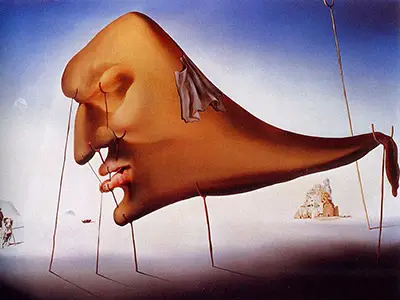The now icon painting features a large and oddly shaped head with no apparent body. The head dominates the canvas. Unlike Dali's previous paintings, that were very obviously self-portraits, this face is not of Dali, but of an unknown person.
As a surrealist painter, Sleep, very much focusses upon the subconscious mind. Within this painting there is a great sense of vulnerability, with the head being supported by several crutches, as though it could fall down at any moment, and be lost to the dream world.
The small dog in the painting also needs to be propped up, highlighting the fact that they are both present in the same dream world. The entire painting is transient, ever moving, and not of our world.
Dali has also chosen to paint the picture in a pale blue hue. This is almost as if the rational and daylight world of those who are awake, are trying to enforce their presence and that what is being depicted on canvas, is simply a dream.
The dream world has been captured beautifully in subtle colours. The bare landscape, the disembodied head, that is plainly vulnerable, all add to this dreamlike quality.
The focus of the painting is that of the large sleeping head. However, other aspects of the painting are of equal importance. The use of size is important. The head is large, while the dog and the castle, that can be seen in the distance, are small.
This all helps with the focussing and attention being placed upon the head. There is also a difference between the left and right side of the head. The left shows clear, facial features, while the right has to be supported. It is widely reported that the right side of the head represents pain, that is also a recurring Freudian theme.

